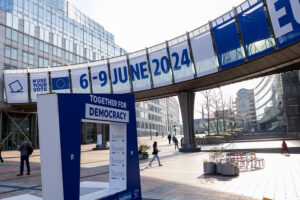Introduction
This analytical synthesis holds particular significance in shedding light on the ongoing discourse among Chinese scholars, aimed at informing the domestic debates over the impacts of the Russia Ukraine war on EU-China relations. It’s crucial to underline that the purpose of this text is to enrich Chinese understanding of how the Russian factor has shaped European policy thinking and practice towards China, rather than to sway the viewpoints of European decision-makers or intellectuals. As such, it serves as a valuable instrument for unraveling the authentic dialogues transpiring among Chinese scholars.
Prof. Shaohua’s expertise encapsulates the intricate interplay between China and the European Union. Rooted in meticulous research and profound insights, this synthesis articulates his perspectives with precision, capturing the nuances of China-EU relations in the context of evolving geopolitical landscapes.
Since the publication of the “EU-China: Strategic Outlook” document in 2019, the EU’s perception and policy towards China have undergone significant changes. This adjustment of the EU’s China policy is the result of multiple factors, including internal EU dynamics, China-EU bilateral constraints, and external influences. The Russian aggression against Ukraine started in February 2022 is the latest external factor that has impacted these adjustments. This conflict, a major post-Cold War geopolitical event, has not only shaken the European security order but has also significantly affected the environment of China-EU relations, becoming a crucial factor shaping their dynamics.
While China is not directly involved in the Russia-Ukraine war, its possible implications have created a notable impact on China’s diplomacy and the development of China-EU relations. This effect was evident during the 2022 China-EU summit. Initially planned to focus on restoring their relations after a period of mutual sanctions in 2021, the summit’s agenda was drastically reshaped by the Russia-Ukraine conflict. This external event had wide-ranging discussions both in China and abroad, particularly in academic circles. Scholars generally agree that the conflict between Russia and Ukraine is reshaping global political and economic structures, hastening adjustments in international order and major power relations. Nevertheless, a comprehensive analysis of how the Russian factor affects Sino-European relations, especially in the context of the Russia-Ukraine conflict, remains uncommon.
Professor Yan Shaohua’s article “The Russian Factor in EU China Relations”, aims at elucidating the Russian factor in Sino-European relations and deeply analyze how this specific factor is influencing their interactions in the context of the Russia-Ukraine conflict. Although China’s relationships with other nations aren’t typically influenced by its ties with Russia, the current state of China-EU relations appears to be an exception. While the American factor has long played a structural role in shaping Sino-EU relations since the establishment of diplomatic ties in 1975, the Russian factor has garnered less attention and still requires further examination from both academia and political circles.
The full paper “Analysis of the Russian Factor in Sino-EU Relations” was originally published in Chinese in “Pacific Journal”, No. 5, 2023, pp. 11-24. The following is a synthesis by Herta Manenti:
New Trends in China-EU-Russia Triangular Relations
The triangular relationship among major powers is a focal point in international relations. While most analysis often centers on China, the United States, and either Europe or Russia, there’s less attention on the triangular dynamics between China, Europe, and Russia. Nonetheless, understanding this relationship is crucial. Even though the United States as the current hegemonic power significantly influences Europe, it’s important to recognise the unique dynamics of the Sino-European-Russian triangle. Amid evolving geopolitical strategies – including the US “rebalance” strategy towards Asia, China’s “Westward” strategy, and the EU’s “Eastward” focus – China-EU-Russia relations are adapting to a new geopolitical landscape. This landscape is particularly evident in recent years, as the interaction between China, Europe, and Russia displays new trends.
First, in the context of EU-Russia relations, Russia strategically leverages China to enhance its position with the EU. As Russia’s largest neighbor, historical and cultural ties exist between the EU and Russia. However, competitive geographical interests have often strained their relationship. The fundamental issue is their divergent views on post-Soviet spaces and European security orders. These differences have led to shifting postures over time, with periods of European expansion eastward. Against this backdrop, the Russia-Ukraine conflict significantly influences EU-Russia dynamics and even transforms them. The EU’s internal crises, combined with global shifts like the US-China competition, have allowed Russia to utilise various contradictions to its advantage, reshaping the power dynamic to its favor. The result is a shift from Russia being on the defense to a more proactive stance against Europe.
Amid these dynamics, Russia taps into its energy supply, using China and Europe’s energy demands to its advantage. For example, Russia signed a substantial natural gas contract with China after the Russian annexation of Crimea in 2014, providing it with both economic relief from Western sanctions and a political bargaining chip against Europe. Russia’s ability to manipulate energy projects like “North Stream 2” by involving China further demonstrates its strategy of using Chinese factors to engage with the EU.
Second, in the context of Sino-Russian relations, Russia employs European and American factors to bolster its ties with China and to counterbalance EU pressures. The Crimean crisis strained EU-Russia relations, leading Russia to prioritise its relationship with China. Their shared positions on international and regional issues have strengthened their ties, culminating in a “comprehensive strategic partnership of coordination in the new era” in 2019. This relationship has proven valuable for Russia, helping it navigate Western sanctions and diplomatic pressures.
While China maintains a non-confrontational stance in its relations with Russia, Russia exploits this relationship to hedge against European and American pressures, especially NATO’s eastward expansion. Russia’s alignment with China has enabled it to push its diplomatic boundaries, as demonstrated by its actions during the Russia-Ukraine crisis. This alignment provides Russia with diplomatic maneuvering space and support, allowing it to confront Europe with more assertive tactics.
Third, within China-EU relations, the EU channels its dissatisfaction with Russia towards China. The EU’s evolving perception and policies towards China have introduced significant changes. Shifting from viewing China as a strategic partner to labeling it a “cooperative partner, economic competitor, and institutional opponent,” the EU’s stance has toughened. Within this context, the Russia-Ukraine crisis has magnified EU concerns. The EU blames China for its issues with Russia, venting its dissatisfaction by associating it with Russia’s challenges. This practice became particularly pronounced after the Russian-Ukraine war began.
Despite China’s balanced stance on the Russia-Ukraine conflict, its global influence and close relationship with Russia led the EU to place higher expectations on China’s role. Consequently, the EU sought China’s involvement as a mediator in peace talks, increasing pressure on China when its efforts fell short. This tension is evident in the EU’s official statements, including those from the 2023 EU-NATO cooperation declaration. This document, for the first time, explicitly addresses China as a “challenge that must be dealt with,” showcasing the increasing convergence between the EU and NATO’s perspectives on China.
In conclusion, the Russia-Ukraine conflict is a pivotal point influencing China-EU relations. The ongoing conflict has prompted the EU to intertwine its policies towards Russia and China. While China’s diplomacy is usually guided by a “non-alignment, non-confrontation, and no targeting of third parties” principle, its relationship with Russia has taken on a unique role. As the Ukraine crisis deepens, the Russian factor might outweigh the US factor in shaping China-EU relations, presenting new challenges and opportunities for the future.”
EU’s Political “Binding” of China and Russia
The Russia-Ukraine conflict has deepened the European Union’s inclination to politically link China and Russia. This approach, often referred to as “political bundling,” stems from Cold War-era ideology, where China and Russia are categorised as “authoritarian” nations. This classification prompts the EU to reconsider its engagement with these nations, grouping them together based on their political systems. Prior to the Russia-Ukraine conflict, the EU and the United States had already aligned their political and ideological policies towards China. They reinforced their shared values and established a “values alliance” while also framing China within a binary framework of “democracy vs authoritarianism.” Even before the conflict, the EU had to some extent intertwined China and Russia within its broader dealings with so-called “authoritarian” nations. This can also be observed in the concept of “institutional opponents” used in describing China’s position. Though this approach has led to a more robust stance on China in recent years, it hasn’t fundamentally altered the EU’s overall China policy. The EU continues to adopt a “trichotomy” strategy towards China, comprising cooperation, competition, and institutional confrontation, with cooperation as the primary focus. This approach significantly contrasts with how the EU deals with Russia.
The EU’s “trichotomy” stance towards China has evolved since its introduction in 2019. While it has gained acceptance among EU institutions and member states, debates persist within the EU about how to strike a balance between the various levels of engagement with China. During an assessment of the “EU-China: Strategic Outlook” document in April 2021, some voices advocated for a tougher approach, emphasising China as an “institutional adversary.” This highlights the ongoing divergence of opinions within the EU regarding the mix of cooperation, competition, and institutional rivalry within its China policy. Striving for equilibrium among these multiple aspects has become the cornerstone of the EU’s China policy in recent years.
The Russia-Ukraine conflict has triggered interconnected shifts in the EU’s approach to China. Firstly, this conflict has altered the EU’s perception of the nature of Sino-Russian relations, cementing its tendency to associate China and Russia in its official discourse. The signing of the “Sino-Russian Joint Statement on International Relations and Global Sustainable Development in the New Era” prior to the conflict was seen as a turning point in Sino-Russian relations. At the Munich Security Conference in 2022, Josep Borrell, the EU High Representative for Foreign Affairs and Security Policy, regarded this statement as an apex in China and Russia’s endeavor to reshape the international order, even labeling it a “revisionist manifesto.” During the “Raisina Dialogue” in New Delhi in April 2022, Ursula von der Leyen, the President of the European Commission, interpreted the Sino-Russian joint statement as an apparent “unrestricted alliance treaty,” expressing concerns about its implications in Europe and Asia. Notably, the political “binding” of China and Russia mainly manifests through the discourse of individual EU leaders, lacking a consensus at the policy level. Some EU nations still advocate for China to maintain distance from Russia, underscoring internal divisions and suggesting that this “binding” could become a burden for the EU.
In tandem with “binding” China and Russia, the EU is strategically leaning towards the United States, strengthening their relationship and shaping a camp-based pattern of “US-Europe vs China-Russia.” The Russia-Ukraine conflict prompted China to reiterate its stance of assessing matters on their merits, upholding sovereignty and territorial integrity, and pursuing peaceful dispute resolution in accordance with the UN Charter. The EU interpreted this as “pro-Russian neutrality” and “strategic support” for Russia. Concerns about China’s stance pushed the EU towards the United States on critical issues related to the China-US competition, further institutionalising EU-China competition.
This “binding” of China and Russia carries significant implications for China-EU relations, presenting challenges in balancing diverse aspects of the EU’s China policy. The impact of the Russia-Ukraine conflict might shift the balance of the EU’s trichotomy approach more towards treating China as an “institutional opponent.” The EU Council of Foreign Ministers’ meeting in October 2022 emphasised economic competition and institutional confrontation, marking a shift in tone post-Russia-Ukraine conflict. While the EU’s multifaceted approach towards China remains, the balance among its various dimensions has begun to pivot from emphasis on cooperation towards competition.
EU’s Rethink on Economic and Trade Dependence
Economically, the Russia-Ukraine conflict has prompted the EU to reassess its economic and trade dependence on Russia and China, and its philosophy of economic cooperation. The conflict has exposed the EU’s energy vulnerability due to its reliance on Russia, leading to contemplation of China-EU economic relations to avoid over-dependence pitfalls. The lessons drawn from the Russian invasion of Ukraine suggest that interdependence is no longer sufficient to ensure security. This shift also impacts Germany’s relations with China. Borell openly acknowledged that the EU’s prosperity historically relied on Russia’s energy and China’s market, while security was tied to the United States. This foundation has proven costly, signaling that the former world order, where the US assured security and Russia and China underpinned prosperity, is no more. Consequently, the EU will no longer separate security from prosperity, factoring security considerations into its economic and trade ties with Russia and China.
The Russia-Ukraine conflict has pushed the EU to reconsider two critical aspects related to economic interdependence. Firstly, the notion of economic and trade cooperation as a “ballast stone” has been challenged. Previously, the EU considered such cooperation as pivotal for gaining Russia’s cooperation and stabilising EU-Russia relations. Despite pressure from the United States and some EU member states, Germany pursued the “North Stream No. 2” natural gas pipeline, aiming to leverage economic cooperation for influence over Russia. However, the conflict demonstrated that economic interdependence and the threat of sanctions couldn’t prevent Russia from taking aggressive actions against Ukraine. The second aspect is the risk of the “weaponisation” of interdependence. Instead of serving as a stabilising element, economic and trade dependence between Europe and Russia transformed into a tool for mutual sanctions after the Russian invasion of Ukraine. This shift was particularly detrimental to the EU, which heavily relies on Russia for energy. The EU responded by imposing comprehensive sanctions on Russia and committing to reducing energy dependence, thereby embarking on a process of “de-Russification” at the economic level.
In comparison to Russia, China and the EU share a deeper and broader interdependence, making a “big decoupling” like that between the EU and Russia implausible. In a speech in March 2023, von der Leyen asserted that decoupling from China isn’t viable or in Europe’s interest. Nonetheless, the EU recognises that the problems encountered in its economic dependence on Russia also apply to China-EU relations. In the context of the Russia-Ukraine conflict, the EU’s perspectives on these issues have evolved.
Increasing Geopolitical and Security Focus in EU’s China Policy
The Russia-Ukraine conflict has amplified the securitisation of China-EU relations, resulting in a heightened emphasis on geopolitical and security aspects within the EU’s China policy. Historically, issues such as geopolitics and security held a secondary status in China-EU relations. This was largely due to the absence of fundamental geopolitical clashes between China and Europe, setting them apart from the distinct nature of Sino-US relations. However, with the EU’s growing commitment to strategic autonomy and its shift in geopolitical power, China and the EU are increasingly encroaching on each other’s geopolitically sensitive domains. The EU labels China’s influence in its neighboring regions as a “geopolitical challenge,” while also extending its geopolitical impact to China’s sensitive regions through the “Indo-Pacific Strategy.” As a result, the traditional narrative of China-EU relations devoid of core geopolitical conflicts is undergoing subtle modifications, ushering in geographical disputes and traditional security matters into the forefront of the EU’s China policy.
This shift and its implications are evident in three key areas:
Firstly, within the EU’s geopolitically sensitive regions, there’s growing scrutiny of China-Russia coordination, particularly in security matters. Historically, the EU viewed Russia as its primary geopolitical challenge and security concern. However, the strengthening Sino-Russian strategic partnership is gradually reshaping how the EU perceives China’s security role, particularly in certain Central and Eastern European nations. For instance, the Baltic countries traditionally focused their security concerns on Russia. Still, the joint China-Russia military exercise in the Baltic Sea in 2017 marked a turning point, as it was seen as tacitly legitimizing Russia’s influence there. The Baltic countries, which initially prioritized economic ties with China, are now showing greater concern for security and geopolitical factors in their dealings. Since 2019, China has been included in the security assessments of these Baltic nations, designated a “security threat” second only to Russia. While this change partly stems from the influence of the United States and domestic politics within these countries, the deepening partnership and security cooperation between China and Russia play a significant role. Before Russia´s invasion of Ukraine, China and Russia jointly opposed NATO expansion in a joint statement, drawing the EU’s attention. This marked the first instance since the 1959 Sino-Soviet confrontation where China openly aligned with Russia on a major European security issue. Post the Russia-Ukraine conflict, the EU has also expressed concerns about potential military support from China to Russia. Nonetheless, it’s crucial to note that a strategic partnership differs substantially from an alliance or alignment, and these concerns might be exaggerated or misconstrued.
Secondly, in China’s geopolitically sensitive regions, the EU has grown more attentive to the Indo-Pacific’s geopolitical landscape, especially concerning the Taiwan issue. Historically, the EU adopted a subdued and pragmatic stance on Taiwan, considering it primarily a concern for the United States. However, pro-Taiwan sentiments within certain EU member states and institutions like the European Parliament have been gaining traction, resulting in heightened EU focus on the Taiwan issue. In September 2021, the EU launched its “Indo-Pacific Strategy,” signifying a shift in its global strategic focus and signaling its evolving concerns in the Asian region. Significantly, the Taiwan issue is also addressed within this strategy, acknowledging that escalating tensions in the South China Sea and the Taiwan Strait impact European security perception. Despite assumptions that the Ukraine crisis might dilute the EU’s Indo-Pacific focus, the EU’s attention towards the Taiwan issue appears undiminished, if not deepened. The Taiwan issue, fundamentally distinct from the Ukraine crisis, has been opportunistically seized by pro-Taiwan forces within the EU to elevate its visibility, suggesting a potential increase in Europe’s engagement with the Taiwan question.
Thirdly, the EU’s overall security strategy now encompasses Russia and China. In 2003, the EU released its first security strategy, “European Security Strategy,” and in 2016, it presented the “EU Global Strategy.” While both documents referenced China, they didn’t categorise China as a security concern. The 2003 strategy considered China, along with other nations, as strategic partners in addressing security challenges. The 2016 “EU Global Strategy” integrated China within its Asia policy, advocating engagement with China based on the rule of law and strengthening trade and investment relations. However, the Russia-Ukraine conflict prompted a collective EU assessment of its strategic environment through the 2022 “Strategic Compass,” the EU’s inaugural defense white paper guiding security and defense strategy for the next decade. Importantly, this document identifies both Russia and China as security challenges. While it doesn’t brand China as an outright security threat, the inclusion signifies the post-Russia-Ukraine trend of heightened securitisation in China-EU relations.
Managing the Russian Factor in China-EU Relations
The Russia-Ukraine conflict underscores the significant influence of Russia on China-EU relations, presenting China with a complex challenge within the China-Europe-Russia triangle. Strategically, Russia holds a vital position as China’s closest major neighbor and a key strategic partner. Meanwhile, the EU carries greater economic significance for China compared to Russia. This intricate dynamic of relying on different third parties in strategic and economic realms becomes more complex when EU-Russia relations become strained. Consequently, China navigates distinct expectations and pressures from both the EU and Russia.
This situation bears similarities to the EU’s own predicament between China and the United States, albeit with significant differences. Unlike the US-China relationship, which has yet to descend into full-scale confrontation, EU-Russia interactions have nearly exhausted all avenues of conflict except outright warfare. In such an environment, tensions naturally escalate in China’s relations with both the EU and Russia. While this isn’t ideal for China’s interests, it does position China favorably within the triangular context of China-Europe-Russia dynamics. By leveraging this favorable stance, China’s diplomacy can carve out more maneuvering space, striving for a conducive international environment.
Effectively managing the Russian influence within China-EU relations calls for a constructive approach to the China-EU-Russia triangular relationship. This involves balancing China-EU and China-Russia relations strategically and adeptly, thereby enhancing diplomatic agility and expanding strategic opportunities. The current state of China-EU relations reaches a pivotal juncture, pivoting around the Russia-Ukraine conflict. Amid the context of Sino-US strategic competition, nurturing the Sino-Russian strategic partnership aligns with China’s interests. Yet, maintaining this partnership while avoiding further deterioration in China-EU relations is a critical challenge for China’s diplomacy. Especially in light of the Russia-Ukraine conflict, mitigating the “spillover effect” on China-EU relations assumes paramount importance.
The EU, pursuing strategic autonomy, emerges as a key actor in shaping the dynamics of Sino-US competition within the context of the Russia-Ukraine conflict. This elevates the EU’s strategic relevance for China, akin to the importance of Russia. Consequently, China must deftly balance deepening the Sino-Russian partnership while preserving stable Sino-European relations. Considering the backdrop of the Russia-Ukraine conflict, geopolitical and security concerns rank high on the EU’s agenda. Establishing mutual security trust between China and the EU becomes urgent. In this vein, the end-of-2022 visit by German Chancellor Scholz and European Council President Michel to China, culminating in a consensus against the use of nuclear weapons, represents a positive stride. Such steps pave the way for mutual security trust and offer a platform for intensified dialogue between China and the EU amidst the Russia-Ukraine conflict.
Efficiently handling the Russian factor in China-EU relations necessitates the EU to recalibrate its approach. This involves accurately comprehending the essence of the China-Russia strategic partnership and its independent trajectory, while refraining from viewing China-EU relations through a lens of strategic competition. China-EU ties now possess global implications, transcending bilateral dimensions. Therefore, it’s diplomatically premature for the EU to anchor China-EU relations within the ambit of third countries like Russia or the US.
The EU’s endeavor to “bind” China and Russia within its foreign relations is unrealistic, given their sovereign status and non-formal alliance nature. Moreover, this approach is counterproductive to fostering China-EU relations, as it fuels China’s mistrust towards the EU. Regardless of China’s choices, altering the EU’s stance or enhancing China-EU relations remains unlikely. Indeed, while China and Russia share common interests in the global system, the Russia-Ukraine conflict underscores their distinct nature and divergent interests. Russia tends to expand its sphere of influence, utilising “manageable conflicts” to secure geopolitical gains and affirm its great power status. In contrast, China seeks integration and reform within the global system, creating a peaceful international environment conducive to its economic growth and modernisation. These differing approaches highlight fundamental distinctions between China and Russia on the global stage, a nuance that should inform the EU’s perceptions and policies toward China.



